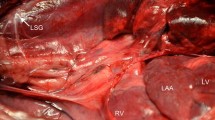Abstract
During transesophageal electrical stimulation of the left atria in patients with heart diseases, an intravenous administration of Sandostatin prolonged the cardiac cycle and the effective refractory period of the atrioventricular junction, slowed down the sinoatrial conduction and the sinus node recovery time, and shifted the Wenckebach's point downwards. Neurotensin produced effects opposite to those of Sandostatin. During the Valsalva maneuver, Sandostatin strengthened bradycardia and broadened the range of heart rate changes associated with the vagal tone variations. The latter effect was also observed after the administration of neurotensin. Met-enkephalin and dalargin shortened the cardiac cycle, increased the corrected time of sinus node recovery time, but did not affect the cardiac rhythm dynamics during the Valsalva maneuver. These findings suggest that the regulatory peptides can be involved in control mechanisms determining the electrophysiological parameters of the human heart.
Similar content being viewed by others
REFERENCES
Osadchii, O.E. and Pokrovskii, V.M., Peptidergic Mechanisms in the Cardiac Rhythm Parasympathetic Regulation, Usp. Fiziol. Nauk, 1993, vol. 24, no. 3, p. 71.
Campbell, G., Gibbins, I.L., Morris, J.L., et al., Somatostatin Is Contained in and Released from Cholinergic Nerves in the Heart of the Toad Bufo marinus, Neuroscience, 1982, vol. 7, no. 9, p. 2013.
Barron, B.A., Oakford, L.X., Gaugl, J.F., and Caffrey, J.L., Methionine-Enkephalin-Arg-Phe Immunoreactivity in Heart Tissue, Peptides, 1995, vol. 16, no. 7, p. 1221.
Crick, S.J., Wharton, J., Sheppard, M.N., et al., Innervation of the Human Cardiac Conduction System: A Quantitative Immunohistochemical Study, Circulation, 1994, vol. 89, no. 4, p. 1697.
Lishmanov, Yu.B. and Maslov, L.N., Opioidnye neiropeptidy, stress i adaptatsionnaya zashchita serdtsa (Opioid Neuropeptides, Stress, and Adaptive Heart Protection), Tomsk, Tomsk Gos. Univ., 1994.
Lin, C.I., Wei, J., Cheng, K.K., and Ho, L.T., Electropharmacological Effects of Sandostatin in Human Atrial Fibers, Int. J. Cardiol., 1991, vol. 31, no. 3, p. 313.
Webb, S.C., Krikler, D.M., Hendry, W.G., et al., Electrophysiological Actions of Somatostatin on the Atrioventricular Junction in Sinus Rhythm and Reentry Tachycardia, Brit. Heart J., 1986, vol. 56, no. 3, p. 236.
Narula, O.S., Shantha, N., Vasquez, M., et al., A New Method for Measurement of Sinoatrial Conduction Time, Circulation, 1978, vol. 58, no. 4, p. 706.
Little, W.C., Barr, W.K., and Crawford, M.H., Altered Effect of the Valsalva Maneuver on Left Ventricular Volume in Patients with Cardiomyopathy, Circulation, 1985, vol. 71, no. 2, p. 227.
Montsevichyute-Eringene, E.V., Simplified Mathematico-Statistical Methods in Medical Research, Patol. Fiziol. Eksp. Ter., 1964, no. 4, p. 71.
Osadchii, O.E., Pokrovskii, V.M., Matsko, M.A., and Cherednik, I.L., Cardiotropic Effects of Somatostatin and Its Antagonist, Byul. Eksp. Biol. Med., 1997, vol. 69, no. 9, p. 263.
Wiley, J.W., Uccioli, L., Owyang, C., and Yamada, T., Somatostatin Stimulates Acetylcholine Release in the Canine Heart, Amer. J. Physiol., 1989, vol. 257, no. 2, part 2, H483.
Lundberg, J.M., Rokaeus, A., Hokfelt, T., et al., Neurotensin-like Immunoreactivity in the Preganglionic Sympathetic Nerves and in the Adrenal Medulla of the Cat, Acta Physiol. Scand., 1982, vol. 114, p. 153.
Bachoo, M. and Polosa, C., Cardioacceleration Produced by Close Intra-Arterial Injection of Neurotensin into the Stellate Ganglion of the Cat, Can. J. Physiol. Pharmacol., 1988, vol. 66, no. 4, p. 408.
Osadchii, O.E., Pokrovskii, V.M., Kompaniets, O.G., and Kurzanov, A.N., Comparative Evaluation of Cardiotropic Effects of Neurotensin and Adrenaline in Cats, Fiziol. Zh., 1996, vol. 82, no. 1, p. 104.
Levy, M.N. and Martin, P.J., Neural Regulation of the Heart Beat, Ann. Rev. Physiol., 1981, vol. 43, p. 443.
Rozanski, G.J., Lipsius, S.L., and Randall, W.C., Functional Characteristics of Sinoatrial and Subsidiary Pacemaker Activity in the Canine Right Atrium, Circulation, 1983, vol. 67, no. 6, p. 1378.
Gulyaev, V.P., Masenko, V.P., Yurenev, A.P., and Titov, V.N., Blood Plasma beta-Endorphin Concentration in the Silent Myocardial Ischemia during Holter's ECG Monitoring, Kardiologiya, 1992, vol. 32, no. 3, p. 11.
Konishi, S., Tsunoo, A., and Otsuka, M., Enkephalins Presynaptically Inhibit Cholinergic Transmission in Sympathetic Ganglia, Nature, 1979, vol. 282, p. 515.
Fuder, H., Buder, M., Riers, H.-D., and Rothacher, G., On the Opioid Receptor Subtype Inhibiting the Evoked Release of 3H-Noradrenaline from Guinea-Pig Atria in vivo, Naunyn-Schmiedeberg's Arch. Pharmacol., 1986, vol. 332, p. 148.
Xiao, R.-P., Pepe, S., Spurgeon, H., et al., Opioid Peptide Receptor Stimulation Reverses beta-Adrenergic Effects in Rat Heart Cells, Amer. J. Physiol., 1997, vol. 272, no. 2, part 2, H797.
Weitzel, R., Illes, P., and Starke, K., Inhibition via Opioid Mu-and Delta-Receptors of Vagal Transmission in Rabbit Isolated Heart, Naunyn-Schmiedeberg's Arch. Pharmacol., 1984, vol. 328, no. 2, p. 186.
Pokrovskii, V.M., Osadchii, O.E., Cherednik, I.L., et al., Met-Enkephalin Involvement in Determining the Vagal Functional Effects upon the Cardiac Rhythm, Dokl. Akad. Nauk, 1993, vol. 328, no. 2, p. 267.
Alboni, P., Malcarne, C., Pedroni, P., et al., Electrophysiology of Normal Sinus Node with and without Autonomic Blockade, Circulation, 1982, vol. 65, no. 6, p. 1236.
Schwartz, P.J., Billman, G.E., and Stone, L.H., Autonomic Mechanisms in Ventricular Fibrillation Induced by Myocardial Ischemia during Exercise in Dogs with Healed Myocardial Infarction, Circulation, 1983, vol. 69, no. 4, p. 790.
Author information
Authors and Affiliations
Rights and permissions
About this article
Cite this article
Osadchii, O.E., Kanorskii, S.G., Pokrovskii, V.M. et al. Effects of Regulatory Peptides on Electrophysiological Properties of the Human Heart. Human Physiology 27, 601–605 (2001). https://doi.org/10.1023/A:1011972629867
Issue Date:
DOI: https://doi.org/10.1023/A:1011972629867




